Why are lionfish considered such a problem? Are lionfish really all that bad?
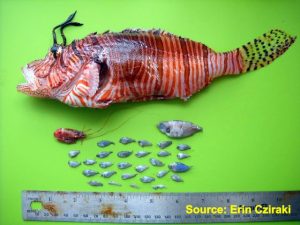 Yes. Non-native lionfish are a terrible problem in the Western Atlantic Ocean, Caribbean Sea and in the Gulf of Mexico, however they are not a problem in their native ranges of the Indian Ocean, Southern and Western Pacific Ocean and in the Red Sea. The world is still waiting to see how bad the problem with non-native lionfish in the Mediterranean is going to get; it is a relatively “new” invasion that is only just really beginning to develop.
Yes. Non-native lionfish are a terrible problem in the Western Atlantic Ocean, Caribbean Sea and in the Gulf of Mexico, however they are not a problem in their native ranges of the Indian Ocean, Southern and Western Pacific Ocean and in the Red Sea. The world is still waiting to see how bad the problem with non-native lionfish in the Mediterranean is going to get; it is a relatively “new” invasion that is only just really beginning to develop.
One thing is for certain, the lionfish invasion is probably the worst man-made ecological disaster ever witnessed and it has yet to completely play itself out. We discuss in detail specific facts about lionfish in other pages of our website but to give you a simple summary of the problem:
Invasive lionfish are out-breeding, out-competing and out-living native fish stocks and other marine species. The consequences impact the food security and economies affecting over a hundred million people.
Lionfish are potentially the fastest breeders in the Western Atlantic Basin.
In favorable conditions female lionfish can release egg masses approximately every 4 days, up to 2 million eggs a year. Lionfish larvae have an incredibly high “recruitment rate” to suitable habitat, meaning that potentially more eggs become larvae, which then become juvenile lionfish settled somewhere that they can grow and live relatively free from environmental pressure. (To put it another way: Lionfish breed faster than rabbits and most of them find good homes with plenty of food.) Lionfish are sexually mature reach 1 year of age and can live well beyond 15 years. There are aquarium owners who have reported having a lionfish live to 20 years old.
Invasive lionfish eat everything that they can fit into their mouths and that their stomachs can handle.
 Lionfish can eat prey over half the size of their own body as long as it will fit into their mouths. Their stomach can expand up to 30 times the normal volume and a lionfish will fill up to capacity as soon as it is able. Lionfish are not picky eaters and feed indiscriminately. Scientists have cataloged over 70 different species that lionfish will eat through stomach content analysis. In addition to the fish they eat, they also eat invertebrates and mollusks – shrimp, crabs, juvenile octopus, squid, juvenile lobster, sea horses, etc.
Lionfish can eat prey over half the size of their own body as long as it will fit into their mouths. Their stomach can expand up to 30 times the normal volume and a lionfish will fill up to capacity as soon as it is able. Lionfish are not picky eaters and feed indiscriminately. Scientists have cataloged over 70 different species that lionfish will eat through stomach content analysis. In addition to the fish they eat, they also eat invertebrates and mollusks – shrimp, crabs, juvenile octopus, squid, juvenile lobster, sea horses, etc.
The native species that invasive lionfish are feeding upon do not recognize lionfish as a predator and flee. In fact, just the opposite has been shown to be true. Small fish will often congregate around a lionfish, most likely believing that the lionfish’s long spines, fin rays and feathery pectoral fins offer them shelter and protection from predators. However, when the lionfish is ready to eat, these fish are herded into alcoves where they cannot escape. Lionfish use lighting fasts strikes and gulp down dozens of whole fish at a time. Science has demonstrated that a single lionfish can reduce native marine creatures by 80% to 90% in its range within just 5 weeks.
The native marine species that lionfish are decimating are important for ecological, commercial, traditional and recreational reasons.
Ecologically important species include the “grazers” and the “cleaners” that maintain the health of the reef and the health of other fish.
 Grazers eat the algae that grows over the reef, they are essentially the lawnmowers that keep the algae levels low enough that coral can get enough oxygen to survive and allow coral to spawn and space for baby coral to settle onto substrate where it can establish itself and grow. Grazers include parrotfish, goatfish, wrasses, surgeonfish & tangs and many others that are favorite prey of lionfish. Not only do reefs provide shelter and protection to entire schools of juvenile marine creatures but some say that reefs and the algae that grows on them may provide as much as 80% of the Earth’s oxygen! Over 42 million people in the Western Atlantic Basin make their living from coral reefs, mainly through fishing and tourism. One doesn’t have to look farther than the Caribbean Sea to see that! The Mesoamerican Reef is the second largest reef system in the world sits squarely in the invasive lionfish’s newly found habitat. If the reef smothers and dies under the additional pressures caused by lionfish, what will happen? We’re not sure that anyone has an educated answer to that question, yet is seems entirely possible.
Grazers eat the algae that grows over the reef, they are essentially the lawnmowers that keep the algae levels low enough that coral can get enough oxygen to survive and allow coral to spawn and space for baby coral to settle onto substrate where it can establish itself and grow. Grazers include parrotfish, goatfish, wrasses, surgeonfish & tangs and many others that are favorite prey of lionfish. Not only do reefs provide shelter and protection to entire schools of juvenile marine creatures but some say that reefs and the algae that grows on them may provide as much as 80% of the Earth’s oxygen! Over 42 million people in the Western Atlantic Basin make their living from coral reefs, mainly through fishing and tourism. One doesn’t have to look farther than the Caribbean Sea to see that! The Mesoamerican Reef is the second largest reef system in the world sits squarely in the invasive lionfish’s newly found habitat. If the reef smothers and dies under the additional pressures caused by lionfish, what will happen? We’re not sure that anyone has an educated answer to that question, yet is seems entirely possible.
Cleaners remove harmful material from native fish and marine creatures. Unlike native species of fish, a lionfish will consume the small fish and invertebrates that “work” in cleaning stations, where reef fish, turtles, and other marine life go to have parasites and other detritus removed, which in turns keeps them healthy. Usually the “cleaners” are relatively free from predation or harm while at work, crawling all over and into the mouths of potential predators. Lionfish are the exception to this rule. They will gorge themselves on cleaner shrimp, wrasse and gobies thereby decimating the cleaning station altogether. The loss of these cleaning stations presents the serious potential decline in the overall health of the creatures that depend upon them to stay healthy and disease-free.
Commercially important species include, for sale, the fish and marine creatures delivered for human consumption and nutritional supplements and put into industrial uses such as pharmaceuticals, animal feeds, pigments, clothing (skins and pearls), fertilizers, etc. There is no doubt that as commercially important species diminish due to lionfish predation that the price of those items will go up. It’s a simple exercise of supply and demand. “Table-fish” supplies commonly served in local restaurants, like grouper, snapper, tunas, etc., will become more difficult to catch in the supplies required and prices will necessarily go up as a result. Eating habits may then shift to other proteins forcing fishermen and entire fishing communities out of business.
Traditionally important species of fish and marine creatures are those marine from which aboriginal people and groups produce their livelihood or use them in accordance with their traditions and history. While not necessarily common in the United States, artesian fishing practices and hyper-local fisheries dependent pockets of people certainly exist in Central and South America. Many indigenous populations require the fisheries resources commonly found in their region to sustain their way of life or produce income in order to survive in an increasingly commercial world. As lionfish predation continues to create unprecedented pressures on these local fisheries, traditional fishing and unique cultures inexorably tied to the sea are also threatened to near extinction.
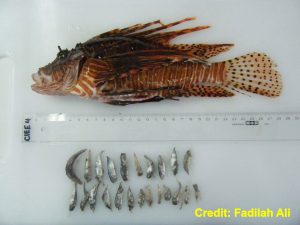 Recreationally important species of marine life are those creatures commonly associated with sport, recreation or for consumption by participants (and not for sale). For example, billfish, mahi mahi, wahoo, jacks, tuna and other “game fish” are specifically prized by anglers while scuba divers really enjoy seeing things like octopus, sea horses, lobsters, crabs and other unique marine life we find special to see on any dive. Lionfish regularly raid the nurseries where juvenile game fish usually find security while growing up and they are eating them in unsustainable amounts. We also know that lionfish eat seahorses, juvenile octopus and lobsters.
Recreationally important species of marine life are those creatures commonly associated with sport, recreation or for consumption by participants (and not for sale). For example, billfish, mahi mahi, wahoo, jacks, tuna and other “game fish” are specifically prized by anglers while scuba divers really enjoy seeing things like octopus, sea horses, lobsters, crabs and other unique marine life we find special to see on any dive. Lionfish regularly raid the nurseries where juvenile game fish usually find security while growing up and they are eating them in unsustainable amounts. We also know that lionfish eat seahorses, juvenile octopus and lobsters.
The impacts reach much further than just the divers and fishermen, however. There are people, indeed entire economies, that depend upon these recreational activities as well… Places like the Bahamas, Caymans, Cozumel, the Bay Islands of Honduras (Utila and Roatán), Bonaire and many others depend upon the tourism-related revenue that sport fishing and scuba diving generates. Diving alone is a $2.1 billion economy in the Caribbean. Businesses like hotels, dive centers, fishing charters, restaurants and all of their employees in areas like these rely upon a steady flow of tourists in search of the best recreational and sport experiences available. If the reef dies and the pretty fish die, scuba divers will choose a different destination. If the sportfish stocks dry up, then sportfishermen stop coming, too. Paychecks dry up, jobs are lost and the economies collapse of those areas unable to make the shift to other industries or sources of revenue.
Lionfish can live in a huge range of water quality, salinity, temperature and depth with relatively no stress.
They have been spotted in water as little as 1 foot (.3m) deep to beyond 1,000 feet (305m) deep. They are equally at home in brackish water river estuaries and mangroves, where most of the juvenile fish grow up. Being able to tolerate water temperatures down to 50 degrees Fahrenheit (10 degrees Celsius) they have established a current range from Rhode Island, United States as far south as Brazil. They are highly tolerant to temperature change and biologically resistant to most diseases and parasites that affect native fish. When food is scarce due to temperature and climate, lionfish can live beyond 3 months without eating anything at all and lose very little body mass as a result.
Lionfish can live in excess of 15 years and have no natural predators in the Western Atlantic Ocean, Caribbean Sea or Gulf of Mexico that are capable of controlling the burgeoning lionfish population.
We are only just beginning to understand the consequences of the lionfish invasion at this point, even the scientists that have been studying the non-native lionfish for two decades are having a really tough time even articulating what the landscape of our local oceans and seas are going to look like ten short years from now. The population explosion has taken most of them completely by surprise and they readily admit that the problem is far worse than could be imagined even six or seven years ago.
Here is what we do know today – these facts are proven:
- Native fish stocks are down as a direct and identifiable result of lionfish predation.
- Commercial fisheries and the lobster industry in places like Florida are crashing as a direct result of lionfish predation.
- Reef health in the Western Atlantic Basin is in serious decline.
- The lionfish population continues to grow at an ALARMING rate and they are establishing their range further south into South America every day.
- Direct action by lionfish hunters is the only viable method for controlling lionfish populations in the very, very small area that we can reach, relative to the entire range of the new lionfish habitat.
- The areas that are regularly maintained by lionfish hunters see a demonstrable rebound of native fish and other sea creatures in time.
- We are rapidly running out of time as we are approaching a tipping point from which our underwater ecosystems cannot recover.
Here’s the bottom line:
Invasive lionfish are disastrously out-breeding, out-living, out-eating and out-competing every other native fish in the Western Atlantic Ocean, Gulf of Mexico and the Caribbean Sea. If left unchecked lionfish will ultimately cause the destruction of the reefs, native fish stocks and the livelihoods of everyone that depend upon them.
Yes, lionfish are really that bad.
We have several additional resources that might be helpful to you as well: Frequently Asked Questions About Invasive Lionfish, Comprehensive List of Lionfish Facts, Most Common Lionfish Myths as well as a 7 Interesting (and Shocking) Facts You Might Not Know about this very serious issue facing our underwater ecosystems in the Western Atlantic Basin.
If you find these facts useful in your research about lionfish and other invasive species, please consider providing a back link to Lionfish.co, giving us a Google+1, a Facebook “like” or a mention on Twitter so that we can continue with our mission and effectively reach others like yourself in a meaningful and educated way.
Thank you!
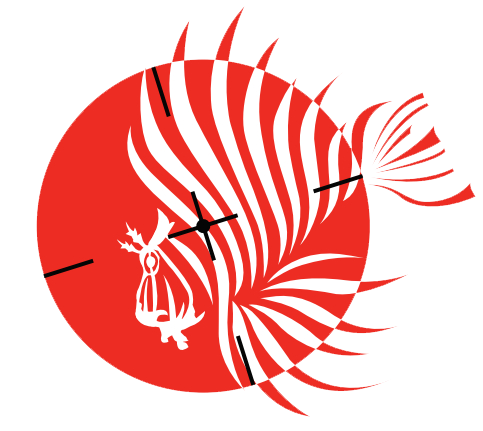
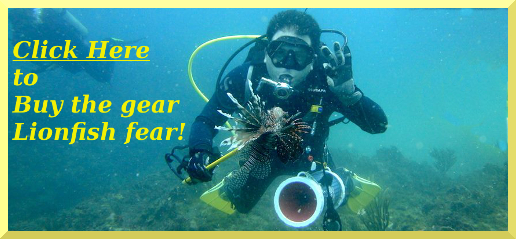

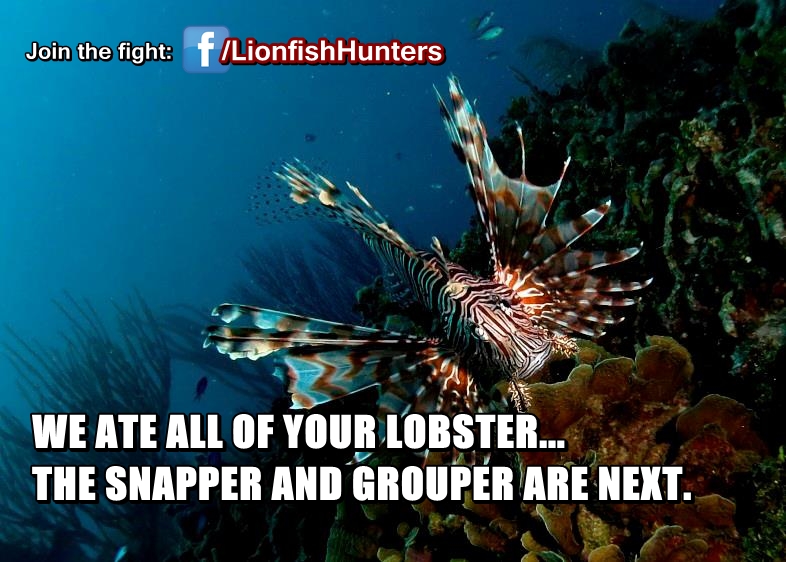

Nice article but ! must say your use of the the word WORLD in your name is discerning. Lion fish DO NOT NEED TO BE ERADICATED in their native waters this word may imply that we need to eradicate them throughout all the world’s oceans.
They are quite tasty and it would be nice to promote this throughout the Caribbean. Florida Keys, Bahamas, VIs and Caymans are showing them on their menu.
Thanks!!! We like it, too.
But, on the off-chance you meant to use the word “disconcerting” rather than “discerning,” I offer this explanation:
We thought that “Western Atlantic Ocean Caribbean Sea Gulf of Mexico and Mediterranean Sea Lionfish Hunters Association” (WAOCSGMMSLHA) didn’t quite roll off of the tongue as eloquently as we wanted, so we chose to use the word “World” instead.
-Scott
Great article…we wrote about this in our blog on my Dive Center’s website, (Sea Dwellers Dive Center of Key Largo).
I’ll post some of your stuff as you post it!
Keep up the good work,
Rob
I agree they are really tasty and they taste like chicken Plus they are the most dangerous fish I have met the sides the blue-ringed octopus and some other very poisonous fish At least lionfish taste like chicken
Thanks for the information. My wife and I vacation in Eleuthera in the winter, and every time I snorkel I bring a short spear and bag a couple of the prickly beasts. This trip was the first time that I ate one, and it was delicious! The captain aboard the ship that my wife and I stayed on for the week (liberty clipper, excellent trip) brought us to popular lion fish hangouts daily. I think the key to eradication, or at least population control is to market them as the delicious and mysterious fish that they are, of which it sounds like is happening, slowly but surely. I know the restaurants in the Bahamas don’t realize this yet. The locals are afraid of the fish.
Very comprehensive and well written article. I live in Belize and South Florida and agree that local awareness of the problem is very slow. Has there been any efforts by such international organizations as the Boy/Girl Scouts to take part in lionfish control in the Caribbean? Are there any articles by economists on the impact of lionfish on local and global economies. You have pointed out very clearly the need for fiscal action…now. Thank you.
Jack Linker
Hey Guys,
Great article! Check out this video of a lion fish awareness bbq here in Grenada!
http://youtu.be/Sc2p69YF_ag
I believe this is what Darwinism theory was about, it is not the strongest nor the smartest but the most adaptable and we as humans are proof of that, why cull somthing when we could possibly find a way to stop the spread maybe some sort of way to stop them even breeding in these area’s this is just me being wishful I guess! I understand why they are a problem and I like that you say in there own native sea they are not.
I discovered one when I was 8 or 9 years old in Clearwater Florida at the King Cole Motel dock! This was around 1958. He (she?) was netted and put into a bucket! The aquarium guy that came said it didn’t belong here and it was not good! It was a scary looking fish to me! I wonder why no one started to do something then? It was the first one the expert had ever seen out of the Pacific? This is over 50 years AGO! Thanks Rick =)
Wow, Great Info,
WOW!Great information, just watched the tv show SHARK and 2 guys were asking for money to help stop these fish, I had no idea how bad it was,Lionfish spearing might be a good thing to invest in..Thanks Scott.
Was in Belieze at the Turneffe Attol first time hunting lion fish on the last day of our trip managed to kill 8 in one dive and had a total of 15 speared and fed to grouper,eels and any other fish who wanted a bite
I have seen a lionfish while snorkeling in Mexico! They are pretty creepy looking, but we were still intrested in it anyway. Thanks for the information- it was really helpful. I am doing a presentaion on invasive species and I thought the lionfish was a great choice. Such a shame, though, how it got into the Atlantic. Hopefully we can get them to “go back where they came from” haha. Thanks again! :))
Is anyone using a vacuum to collect them seems it would be safer, faster and easier?
So although all is well with the idea of whipping out lion fish, my question is when will the hunt be “officially over”. Just as is its over populated now, how much hunting will need to be don before lion fish are down to a population that is suitable for the ocean? Why not relocate some of th4e fish to another area where food is needed. Fish is fish. it can be consumed so why not move it/sell it to other countries in need of the food? #JustAsking
My husband and I visited the Caribbean for the first time (St. Maarten) in October. I’m usually a scardy cat with the ocean, I’m not a great swimmer but I wanted to try snorkeling. We were very close to the beach, along the rocks in inly waiste deep water and saw one. Shortly after a scuba instructor came in the water with his spear and tracked it down and got it out. I will say now I’m feeling more concerned about doing this again. Am I panicking? I loved being out there but oh man, I’m terrified of getting stung!
Let’s ask Trump to build a wall under water to keep them out. jk 🙂
Great article, I just saw one yesterday while diving in Key Largo and now I regret I did not kill it.
Lol! …and we’ll get the lionfish to pay for it! 🙂
EDGY!!!!XDDDDD Dank WEEd snoop Lion 4/20
I think lion fish are a big problem to our underwater ecosystem and should be contained as quickly as oossible
What keeps the lionfish in control in it’s native environment?
Natural predators in the Indo-Pacific and Red Sea that are known to eat lionfish include sharks, cornetfish, grouper, large eels, frogfish and other scorpionfish. There is speculation that large snapper and some species of trigger fish eat lionfish in their native ranges as well.
THE LION FISH ARE SPREADING TOO MUCH, WE MUST GET RID OF LIKE HALF OF THEM, SO THEY DON’T EAT EVERYTHING ELSE!!!!
This lionfish is a real issue, cannot understand why the governaments are not doing anything about it, it is like they are waiting untill the whole emarine system rolls to shit than they will take millions of dollars to reinvent nature.
Everyone looks at fucken money, even YouTube wants to shut my channel off if I do not have enough retention from audience because there were reports that my channel is “cruel” to lionfish.
Help me by subscribing on my YouTube channel and spread my videos that show how to catch lionfish and handle this fish.
When was this article last updated as I need it for my MLA?
The page is current, all of the information is still accurate.
Why not sell them to the aquarium trade…they are hardy and won’t die like other species…and if they bother you in the aquarium…switch the heaters off
Excellent article that ReefSave.org is linking to for public education. Spearing of invasive lionfish is recognized by NOAA as a good stop gap measure. However, humans need to consume lionfish on a massive scale to restore ecological balance, and to create that supply, commercial lionfish traps need to obtain NOAA approval. That is the current problem with harvesting lionfish as a industry. ReefSave.org is a volunteer 501(c)(3) organization working on getting NOAA approval for lionfish traps of various designs. We are looking for lionfish designs to test and volunteers AUG 11 – SEP 22, 2018 to SCUBA dive and record data, make observations and collect video and still images of traps. We are working with Dr. Steve Giddings of NOAA to design tests to obtain NOAA approval for commercial use in the U.S. of lionfish traps and for testing hand built designs that can be local built in the Caribbean and Central America as it is not just a U.S. problem. Our volunteers will SCUBA dive to help answer these questions: how does the trap fall through the water, any impact damage, is the Fish Aggregation Device (FAD) effective, what are the feeding patterns, what are the entanglement risks, is by catch a problem, what is the optimum soak time, do some traps work better than others in different depths and bottoms, how does the other marine life react to the trap, is there any risk of ghost fishing? There will also be biological reef surveys before and during the 6 week testing period and training will be provided. Please consider volunteering with the testing or by helping spread the word so that we can find the volunteers to do the tests needed for NOAA approval. Every person who helps will make a big difference. It’s been 20+ years and there is no time to waste, so let’s: DO SOMETHING NOW!
Like 👍
I was searching for a proper explanation of how to best spotlights for long distance and hunting. Thanks, admin, for sharing such wonderful content on this topic. Now I have got everything I need about it.
Hi,
I’m doing research on how the Lionfish is effecting our coral reefs and marine life ecosystem. I was just wondering who published this? I don’t see a name or the year. Thank you!
Hi Tracy, this was written a few years ago by the late Scott Harrell who started the website. The information is all fully researched and still accurate today.